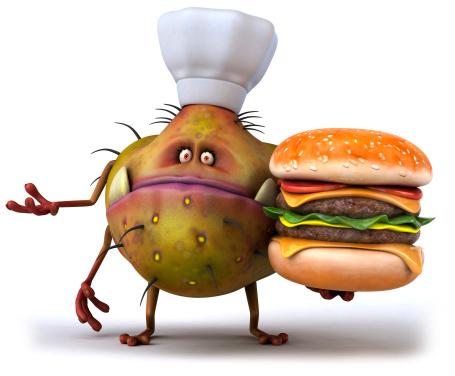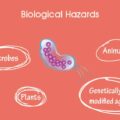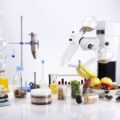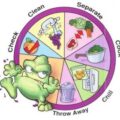Food contamination is generally defined as foods that are spoiled or tainted because they either contain microorganisms, such as bacteria or parasites, or toxic substances that make them unfit for consumption. A food contaminant can be biological, chemical, or physical in nature, with the former being more common.
Food contamination is a severe public health problem around the world, resulting in food-borne diseases that affect human beings every year. When we consume food or drink, we expect to enjoy it and do not expect to get sick or injured. In this article, we will look at the types of food contamination and their examples.
Types of food contamination
Biological Contamination
Biological contamination occurs when food becomes contaminated by living organisms or the substances they produce. This includes biological matter produced by humans, rodents, insects, and microorganisms. Biological contamination is the leading cause of food-borne illness and food poisoning, and a common cause of food spoilage and food waste. There are six types of microorganisms that can cause food-borne illness: bacteria, viruses, parasites, protozoa, fungi, and prions.
Most food-borne illnesses are caused by bacteria or viruses, with the most common being:
- Norovirus
- Listeria
- Salmonella
- E. coli
- Campylobacter
Food-borne illness occurs when disease-causing microorganisms, also called pathogens, get into food and multiply to unsafe levels before being eaten. This can happen remarkably quickly; in conditions ideal for bacterial growth, one single-cell bacteria can become two million in just seven hours.
Bacteria and other pathogens thrive in foods that are:
- moist
- high in protein or starch
- neutral in acidity
Foods that meet these criteria are called potentially hazardous or high-risk foods. All high-risk foods are teeming with pathogens and other bacteria; it is your responsibility to stop bacteria from multiplying to unsafe levels and, where possible, to destroy them via the cooking process.
To slow down the growth of bacteria and prevent food safety risks, you need to follow food safety best practices designed to control bacterial growth through proper food handling techniques, rigorous cleaning and sanitizing procedures, and time and temperature control of food.
Food poisoning occurs when specific toxins are consumed, such as those produced by Salmonella, Staphylococcus, or Listeria; microbial toxins are extremely potent toxins that can disable the immune system and damage tissues if they are consumed. Many microbial toxins are heat-resistant, so even if bacteria are destroyed in the cooking process, the toxins remain in the food and can cause violent, almost-instantaneous symptoms.
To minimize the risk of biological food contamination occurring in your food business, always:
- keep high-risk foods (e.g. meat, poultry, dairy, eggs) out of the Temperature Danger Zone**
- purchase, store, thaw, prepare, cook and serve high-risk foods properly
- regularly clean and sanitize all food contact surfaces and equipment
- maintain good overall hygiene and sanitation of the premises
- maintain high standards of personal hygiene (and ensure all employees do the same)
Physical Contamination
Physical contamination occurs when a physical object enters food at some stage of the production or preparation process. Physical objects in food can be a choking hazard and often introduce biological contaminants as well. Even if the object is not likely to injure your customer, finding an object in their food can be very distressing for a customer (who knows that harmful microorganisms on the object could make them ill).
Common examples of physical contaminants in food businesses include:
- hair
- fingernails
- bandages
- jewelry
- broken glass, staples
- plastic wrap/packaging
- dirt from unwashed fruit and vegetables
- pests/pest droppings/rodent hair
To minimize the risk of physical food contamination occurring in your food business, always:
- wear hair neatly tied back or wear a hair/beard net
- keep jewelry to a minimum
- when necessary, wear brightly colored bandages that can be easily seen if they fall off
- throw out and replace cracked, chipped, or broken dishware, glassware, and equipment
- use a plastic or metal scoop for ice (never use the glass!)
- wash fruits and vegetables thoroughly
- establish pest prevention and control procedures as part of your Food Safety Plan
Chemical Contamination
Chemical contamination occurs when food comes into contact with or produces toxic chemicals, which can lead to chemical food poisoning. Chemical contaminants fall into one of two categories: natural and artificial.
Common chemical contaminants include:
- cleaning products (e.g. detergent, sanitizer)
- pesticides/herbicides
- toxic chemicals in metals and plastic
- preservatives
- naturally occurring toxins
Naturally occurring toxins are toxic compounds that are produced by living organisms, some of which are staples of the human diet (e.g. shellfish, potatoes, fish). These toxins are not harmful to the organisms themselves but can be harmful to us if we eat them.
Minimal contamination with natural toxins might not lead to illness, but Food Handlers should be aware of which foods produce toxins and take all reasonable precautions to ensure that food is safe for consumption. Potatoes, for example, produce glycoalkaloids that are toxic to humans. The majority of these toxins are contained in or just under the peel, and in any eyes or sprouts on the potato. Green skin can indicate the presence of toxins, so be sure to remove any eyes, sprouts, or green skin if you decide to use potatoes that have greened or sprouted.
There are many ways that food can become contaminated by artificial/synthetic chemicals in a commercial kitchen. Food Handlers can accidentally cause chemical contamination if they:
- don’t store cleaning products and other chemicals properly
- use too much detergent or sanitizer to clean food preparation surfaces, glassware, dishes or cutlery (follow the manufacturer’s instructions!)
- don’t rinse surfaces, glassware, dishes, or cutlery properly after cleaning and sanitizing (if applicable)
- don’t properly wash fruits and vegetables to remove pesticides
- use kitchen equipment or containers made from materials that are not suitable for food or not designed to be reused (use only food-grade plastic and metals)
- use pest control products (e.g. spray, poisonous bait) improperly
To minimize the risk of chemical contamination occurring in your food business, always:
- label and store chemicals separately from food
- use the appropriate chemical for the job you’re doing
- follow the chemical manufacturer’s instructions with regards to dilution, contact time, and water temperature
- use chemical pest control products with extreme care or outsource pest eradication to a professional pest control service
Cross-Contamination
Cross-contamination is the accidental transfer of contaminants from one surface or substance to another, usually as a result of improper handling procedures. In a food setting, the term refers to the transfer of contaminants from a surface, object, or person to food. Cross-contamination usually refers to biological contamination but can also be physical or chemical.
Cross-contamination in a food business often occurs as a result of:
- Food Handlers (e.g. microorganisms from sweat, sneezing/coughing, hands, hair, clothing)
- improper food handling techniques (e.g. reusing cutting boards or utensils for raw and cooked food or for different types of food)
- improper cleaning and sanitizing (e.g. not properly rinsing cleaning chemicals from preparation surfaces, dishware, glassware, or equipment)
- improper food storage (e.g. storing raw meat on shelves above ready-to-eat food)
- improper waste disposal (e.g. allowing garbage containers to overflow)
- pests
Cross-contamination can also pose a risk to customers with food allergies, as trace amounts of an allergen can be transferred in the same way that microorganisms can. Even trace amounts of an allergen can cause a serious allergic reaction — in some cases, a lethal reaction. As a food business owner, manager, or employee, it is your responsibility to serve customers a safe meal, including customers with food allergies.
To minimize the risk of cross-contamination occurring in your food business, always:
- move around the business in accordance with the Food Safety Plan (e.g. change soiled kitchen clothing before moving from raw food to ready-to-eat prep stations)
- cover and store raw food on shelves below cooked or ready-to-eat food in the refrigerator
- use separate equipment or utensils to prepare raw and cooked foods
- use separate equipment or utensils to prepare different types of foods
- prepare allergen-free meals separately
- establish allergen management procedures as part of your Food Safety Plan
- maintain high standards of personal hygiene
- wash hands frequently using the correct handwashing technique
- handle and dispose of food scraps and waste properly (e.g. ensure garbage containers are sealed and stored away from food)
Pests deserve a special mention in this regard, as they are notorious sources of cross-contamination in food businesses. Rodents, flies, and cockroaches carry untold numbers of disease-causing bacteria and other pathogens on their bodies, in their droppings, and in urine and saliva, including Salmonella, E. coli, and Listeria.






